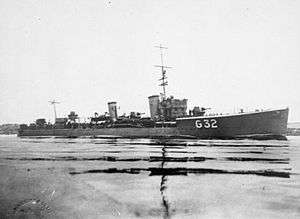HMS Scythe (1918)
 Scythe in 1918 | |
| History | |
|---|---|
| Name: | HMS Scythe |
| Ordered: | June 1917 |
| Builder: | John Brown & Company, Clydebank |
| Laid down: | 14 January 1918 |
| Launched: | 25 April 1918 |
| Completed: | July 1918 |
| Fate: | Sold for breaking up 28 November 1931 |
| General characteristics | |
| Class and type: | S-class destroyer |
| Displacement: | 1,075 tons |
| Length: | 276 ft (84 m) o/a |
| Beam: | 26 ft 9 in (8.15 m) |
| Draught: | 10 ft 10 in (3.30 m) |
| Propulsion: | Brown-Curtis, steam turbines, 2 shafts, 27,000 shp |
| Speed: | 36 knots |
| Range: | 250-300 tons of oil |
| Complement: | 90 |
| Armament: |
|
| Notes: | Pennant number: G32; H22 (from 1925) |
HMS Scythe was an S-class destroyer of the Royal Navy.[1] She was ordered on 23 June 1917 from John Brown & Company, Clydebank; construction began on 14 January 1918, she was launched on 25 May 1918 and completed on 7 July 1918: a total of 25 weeks.[2] On trials she obtained a speed of 33.485 knots at 1,198 tons displacement.[3] She saw service during the First World War and was involved in the Irish Civil War in the interwar period before being discarded in 1931.
Service history
Scythe served in the 12th Destroyer Flotilla of the Grand Fleet 1918-19, moving to the new 7th Destroyer Flotilla at Rosyth in 1919 before going into reserve at Devonport on 12 November 1919. Subsequently, she was re-commissioned on 4 April 1923, as an independent command in Irish waters after the establishment of the Irish Free State. Between October 1923 and January 1925 her first lieutenant was Frederick Bell,[4] later to earn fame as the captain of HMS Exeter during the Battle of the River Plate. HMS Scythe was involved in a shooting incident at Queenstown (modern-day Cobh) on 21 March 1924, when machine gun fire was directed at her.[5] She continued to serve in Irish waters until she was laid up, before being sold on 28 November 1931 for breaking by John Cashmore Ltd (Newport), arriving December 1931.
Commanding officers
- Lt. Cdr. Evelyn H. B. L. Scrivener (22 June 1918)
- (reduced to reserve, Devonport, 12 November 1919)
- Cdr. Herbert W. Wyld DSO (9 February 1920)
- Lt. Geoffrey S. Grenfell (acting, temporary) (June 1920)
- (recommissioned 4 April 1923)
- Lt. Cdr. A. Knubley (17 March 1924)
- Lt. Cdr. L. T. C. Hill (1 September 1925)
- (reduced to 3/5-th complement, 28 December 1925)
- Lt. Cdr. J. G. Crossley (31 December 1927)
- Lt. Cdr. F. E. Wilmot-Sitwell (21 August 1928)
- Lt. Cdr. F. C. Husband-Clutton (20 August 1929)
- Commissioned Engineer T. G. Rayleigh (3 March 1931)
- (recommissioned in the Reserve Fleet as tender to Comus, Devonport, 26 May 1931)
Notes
- ↑ http://www.clydesite.co.uk/clydebuilt/viewship.asp?id=2029
- ↑ March, British Destroyers, p.219.
- ↑ March, British Destroyers, p.216.
- ↑ Royal Navy (RN) Officers 1939-1945
- ↑ Rolls-Royce Armoured Cars
References
- Dittmar, F.J. & Colledge, J.J. (1972). British Warships 1914–1919. Shepperton, UK: Ian Allen. ISBN 0-7110-0380-7.
- March, Edgar J. (1966). British Destroyers: A History of Development 1892-1953. London: Seeley Service & Co.